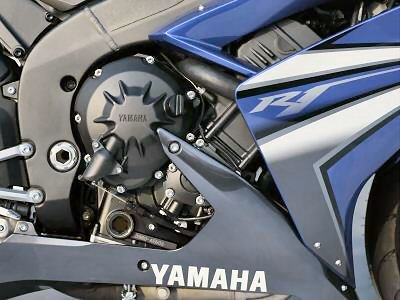Gyroscopic precession, from the engine
 The spinning of the wheels with the axis of rotation perpendicular to the direction of motion, generates gyroscopic precession and consquently stability. The engine's crankshaft does exactly the same thing too. It rotates on an axis perpendicular to the direction of motion... yes, it also aids stability. So if you're in a tricky situation, you are probably better off revving the engine higher than lower...
The spinning of the wheels with the axis of rotation perpendicular to the direction of motion, generates gyroscopic precession and consquently stability. The engine's crankshaft does exactly the same thing too. It rotates on an axis perpendicular to the direction of motion... yes, it also aids stability. So if you're in a tricky situation, you are probably better off revving the engine higher than lower...
Of course, if you have ridden a boxer BMW, you will know the effect is noticeable, but not significant. The BMW boxer crank has its axis parallel to the direction of motion, and at idle, blipping the throttle is enough to rock the near-200 kg bike from side to side gently.
But there is a counter argument. There always is. If you were seated on your motorcycle at standstill, and rocked the bike from side to side while raising the engine speed (rpm) in neutral, would you need more force to rock it as the revs climbed?





















5 comments:
hi rearset...
just love your blog. am a non-biker who just learnt to ride. and i'm slowly falling in love with the idea of two wheels under me.
wanted to know something...just to better understand how a bike enthusiast feels. does the mileage your bike give really matter when you're moving fast on the road?
would be great to know what you think about the mileage/power/adrenalin rush debate.
cheers
fitm
Hi,
While we await Rearset's response here are some thoughts
1. If you can get to the next pump fast enough mileage does not matter, it's how many beers to the tank full you get that count (after the ride ofc, we recommend KF, chilled)
2. Definition of fast is significantly faster than Mr Bean's attempted getaway to Cannes. And at least as safe :). Which is all a round about way of saying "fast" is a relative term
3. *My* adrenalin rush threshold levels: on the highway, increased heart rate, insane "I am alive feeling" leaving a slightly bitter taste in mouth but inners dry and comfortable. Mileage/ speed are only loosely correlated with adrenalin threshold levels. More frequently is a beast (4 wheeled or legged)
4. I have acquired the great responsibility part, am waiting for the great power part to show up. All experience being 18 bhp/ 2.8 kgm. While it does meet 1. 2. and 3. a little more would not hurt :))
and finally it's got to move you not just move you
aplgs in advance rearset.
ciao
PS : Is/ Was there ever a debate ?
PPS: I have different positions on the mileage issue before/ during/ after a ride. a position that is further modulated based on the day of the month :)
@fitm
Mileage? What's that? No, I personally never bother with the fuel or the rate it is being consumed at unless it is time to fill'er up again. Straight answer? No, mileage at speed is irrelevant. Even as a student, I'd use the bike for power, when money ran out, I'd park it until I had more... I had an RD that went like the blazes and returned between 6 and 8 kpl... never thought twice about it...
Hi rearset been a keen reader of your blogs. I really admire u r technical know how but just a small correction.
In boxer engines the crank spins perpendicular to the direction of linear movement. Where as in normal bikes it is same axis as the direction of Linear motion.
No, I think I haven't got it mixed up. The Boxer engine (like BMW) has a crank placed along the length of the chassis, with the engine sticking out the sides. The axis of rotation, therefore, is parallel to (and almost coincident on) the direction of linear motion. On the other hand, the crankshafts of most 'normal' engines, are placed at right angles to the axis of the chassis, and therefore, the axis of the rotation of these crankshafts is perpendicular to the direction of linear motion. If I could add an image to this comment, I'd draw this out and it'd be clear in an instant...
Post a Comment